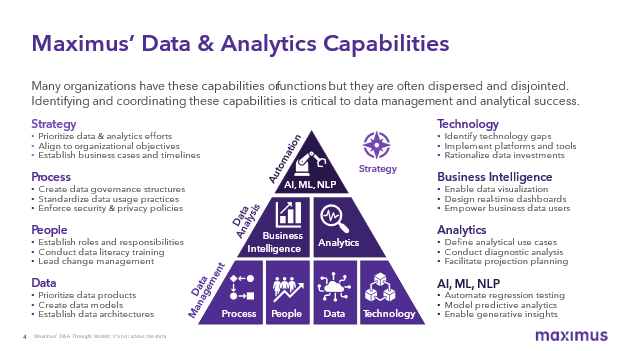
It’s not about the data, it’s about what it lets you see
The Challenge
As technological innovation accelerates, organizations acquire promising new data & analytics (D&A) capabilities piece by piece. These capabilities can grant remarkable new insights into operations and uncover new avenues to growth.
But without an overall strategy and picture of their needs, an organization’s ability to act on that data doesn’t improve – it deteriorates. Dispersed and disjointed data & analytics leads to:
- Data silos within and between business units;
- Lack of coordination between business and IT;
- Redundant investments and excessive IT costs; and
- Multiple, conflicting versions of the truth.
Maximus Data & Analytics Thought Model
Identifying and coordinating D&A capabilities is the key to successful data management and analytics. To guide its clients, Maximus has grouped these capabilities into the four broad categories outlined below:

Strategy
Although the Maximus thought model provides an overall approach to D&A capability growth, the D&A goals need to be identified and aligned to business strategies, goals and priorities.
An effective D&A strategy allows organizations to prioritize their data & analytics efforts, align to organizational objectives, and establish business cases and timelines to support them. The beginning of any D&A journey needs to begin with establishing a direction for future growth.
Data Management
Successful D&A model must be built from the ground up. These practical and policy-driven Data Management approaches create the solid foundations for high quality and accessible data.
Aligning the data management and governance processes with the people and technology capabilities enables the creation of data products, models and architectures which fit the needs of the data users and enables further analytical efforts.
Data Analysis
With a robust Data Management core in place, analysis of this data consists of two capabilities. business intelligence enables data visualization through real-time dashboards, putting complex information into easily digestible screens to empower business data users to identify what happened.
On the other hand, analytics enables diagnostic analysis to identify why it happened and facilitate projection planning of what will happen next. Together, they provide a view not only into today's stats, but tomorrow's trends and how the organization should adapt in the future.
Automation
With all other pieces in place, organizations can maximize the value of artificial intelligence, machine learning, and natural language processing tools to enable generative analysis to accelerate analytical cycles.
These tools allow you to automate regression testing, model predictive analytics and enable generative insights. They provide unprecedented freedom to refine your D&A, and to expand the scope of what we can accomplish.
Move Forward with Maximus D&A Consulting
With our Data & Analytics model, Maximus brings the structure to make sense of your data. As part of our D&A consulting approach, we will identify gaps in your existing capabilities that need to be addressed. Identifying overlapping capabilities will also enable reduced IT spend and rationalize costs.
We will enable collaboration, through new frameworks to govern and coordinate D&A capabilities. This brings with it transparency, and a single source of truth for data across your organization.
Your D&A journey with Maximus will also accelerate innovation: the information you receive will help prepare your organization for modern technologies and new developments on the horizon.
Without a comprehensive strategy and thought model behind it, Data and Analytics is like a dictionary. It has all the information, and it's all true. But it doesn't tell a story.
Let's start the next chapter.
